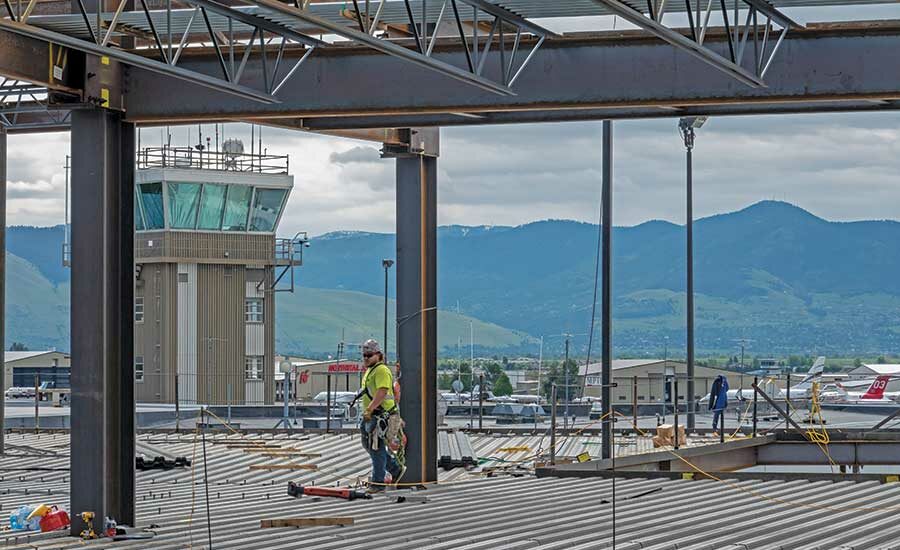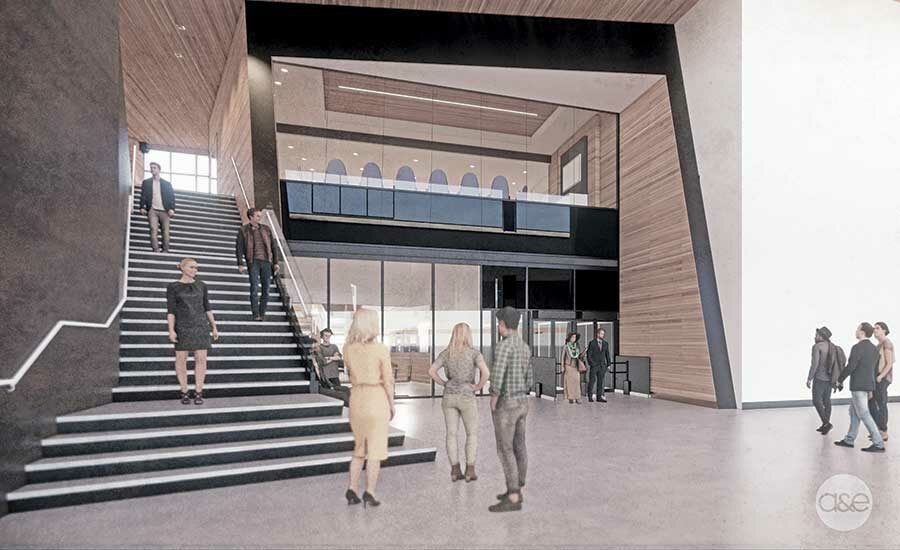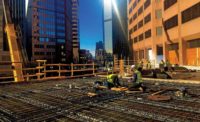Airports
Missoula’s New Airport Will Improve Passenger Service in Western Montana

The new three-story terminal is being constructed in two phases on the site occupied by the previous facility. The extensive use of glass will provide good views of the surrounding mountains.
PHOTO COURTESY OF MARTEL CONSTRUCTION

Extensive use of glass will allow daylighting throughout the terminal, and wood finishes reference the area’s timber industry.
IMAGE COURTESY OF A&E ARCHITECTS

Despite a temporary challenge in getting insulation materials for the project, the building envelope was closed before winter and interior work got underway.
IMAGE COURTESY OF MARTEL CONSTRUCTION

While the new terminal abuts the existing airport, there is enough physical separation between the facilities so that crews can work without interrupting airport operations.
IMAGE COURTESY OF MARTEL CONSTRUCTION

The new facility will rise three levels, with administrative offices on the top floor.
IMAGE COURTESY OF MARTEL CONSTRUCTION

A roof overhang at the front of the terminal will have an aluminum soffit with the appearance of natural wood and recesses through the curtain wall.
IMAGE COURTESY OF MARTEL CONSTRUCTION

Large windows will provide daylighting in nearly all areas of the new terminal. Designers wanted movement through the terminal to be easy and intuitive.
IMAGE COURTESY A&E ARCHITECTS







For residents of rural western Montana, the Missoula airport serves as a key connection to the wider world. For visitors, it’s a gateway to Glacier National Park, rivers with world-famous fly fishing and many high-mountain lakes. But the current airport has undergone numerous expansions and remodels over the decades and is not equipped to handle the area’s growing passenger traffic.
“We’ve set records for the numbers of passengers each year for the past 11 years, and we reached just under a million in 2018,” says Cris Jensen, airport director for the Missoula County Airport Authority. “Then things have dropped off because of COVID-19, but we expect our numbers to come back up as things get back to normal.”
To accommodate the steadily rising number of users, a full replacement of the airport, originally built in 1948, is now past the halfway point. The $111-million, 212,000-sq-ft facility is rising essentially in the same footprint as the current facility, which will be torn down as work progresses.
The project broke ground in 2018 with the relocation of a security checkpoint and demolition of the airport’s west wing to prepare the site for a new terminal. The first phase, priced at nearly $70 million, is scheduled for completion near the end of this year, and the second phase will be completed sometime in 2022. The new airport will house eight gates, two more than the current facility, and will serve seven different airlines.
Architect Chris Martison, a principal at Missoula-based A&E Design and a principal on the airport project, says the design team originally started work in 2013 on a master plan for the airport that was focused on using the existing facility.
“The amount of remodel and phasing, the time and expense it would take to keep using the building just wasn’t the best use of the money moving forward, and they would just be better off with a new building. That is when we shifted gears and started looking at something new,” he says.
Montana Modern
The new terminal will consist of three levels. The first two levels of the facility will serve arriving and departing travelers with airline check-in and ticketing, security and amenities, while the third level will house administrative offices.
Featuring glass, concrete and wood, the terminal will reflect the rugged Montana surroundings as well as accommodate more passengers with greater ease, Martison says.
“We wanted to take advantage of the views of the Missoula Valley. We are trying to celebrate Missoula and this area. The glass also lets plenty of light in. Almost every area of the terminal will have daylighting,” Martison says. “When you come through security, you will face a wall of glass to the north with views of the mountains.”
The glass curtain wall makes up the majority of the building’s facade and will feature photochromic glass that tints in direct sunlight to help control heat gain.
The daylighting also will aid in wayfinding, another main driver of the design, according to Martison. “We were focused on the user. We want to make moving through the terminal easy and have very intuitive wayfinding,” he says. “We also wanted to design with an eye toward future expansion for a growing community.”
Martison says wood and wood-like finishes are prominent in the design. “We wanted to reference this area’s historic ties to the timber industry, so we have a lot of wood in the passenger waiting area and all around the facility.”
A roof overhang at the front of the terminal will have an aluminum soffit with the appearance of natural wood and recesses through the curtain wall. The materials selected are also easy to maintain. “We want a good, durable and sustainable facility for the owner,” Martison says.
The terminal will feature more amenities on the “secure” side, after passengers clear TSA security, than were available at the old facility, he says. Like many new airports, dining options will feature local businesses, with Missoula-based Black Coffee Roasters and Kettle House Brewing Co. already confirmed as tenants. In addition, passenger holding areas for 150 passengers, larger than in the previous airport, will feature multiple electronic-charging stations and improved Wi-Fi service throughout the facility.
From the Ground Up
Following demolition of the west end of the existing terminal, the site was excavated and shored for a new foundation, says Travis Frey, vice president for Missoula-based Martel Construction, which has the CM/GC contract for the project.
“The soil here is all clay, so we had to stabilize the site with about 337 rammed-earth geopiers, and we also brought in rock to build up the soil,” Frey says.
Work on the new access road got underway along with placement of new utility lines. Frey says Martel self-performed all the concrete work, and because the firm specializes in woodwork, it will be doing much of the interior finish work as well.
Once the new terminal is complete and operating, the remaining portion of the existing airport will be demolished to allow for construction of the second phase.
“That next phase will have more baggage claim and rental car facilities, four more gates and some additional restrooms, but we’ll be fully functional in the new terminal while that phase is being finished,” Jensen says.
The widened access road was completed in July 2020, ahead of schedule. Improvements to the surface parking lot were also completed early because COVID-19 restrictions slowed air travel across the country and there were fewer cars parked at the airport.
Frey says pandemic-related project challenges included delays in getting certain materials. “It has been tough to get the mineral wool and fiberglass insulation we need. It has been allocated to suppliers based on previous years’ activity. Now this is the biggest project in Missoula by far, and it has slowed us down a few times finding what we need,” he says.
There was also some anxiety about delivery of two escalators coming from manufacturers in China. “We got a notice when COVID-19 hit that there might be delays in shipping them,” Frey says. “They are large items we wanted to get in before we started closing the building up. We got them on site just in time and got them in.”
While the new terminal abuts the existing airport, there is a physical separation between the facilities. “We’ve been pretty fortunate we’ve been able to carry on our work during COVID-19 shutdowns,” Frey says. “We have very little contact with the users of the airport now.”









